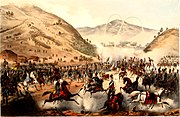| Millennium: | 2nd millennium |
|---|---|
| Centuries: | |
| Decades: | |
| Years: |
| 1848 by topic |
|---|
| Humanities |
| By country |
| Other topics |
| Lists of leaders |
| Birth and death categories |
| Establishments and disestablishments categories |
| Works category |
| Gregorian calendar | 1848 MDCCCXLVIII |
| Ab urbe condita | 2601 |
| Armenian calendar | 1297 ԹՎ ՌՄՂԷ |
| Assyrian calendar | 6598 |
| Baháʼí calendar | 4–5 |
| Balinese saka calendar | 1769–1770 |
| Bengali calendar | 1255 |
| Berber calendar | 2798 |
| British Regnal year | 11 Vict. 1 – 12 Vict. 1 |
| Buddhist calendar | 2392 |
| Burmese calendar | 1210 |
| Byzantine calendar | 7356–7357 |
| Chinese calendar | 丁未年 (Fire Goat) 4545 or 4338 — to — 戊申年 (Earth Monkey) 4546 or 4339 |
| Coptic calendar | 1564–1565 |
| Discordian calendar | 3014 |
| Ethiopian calendar | 1840–1841 |
| Hebrew calendar | 5608–5609 |
| Hindu calendars | |
| - Vikram Samvat | 1904–1905 |
| - Shaka Samvat | 1769–1770 |
| - Kali Yuga | 4948–4949 |
| Holocene calendar | 11848 |
| Igbo calendar | 848–849 |
| Iranian calendar | 1226–1227 |
| Islamic calendar | 1264–1265 |
| Japanese calendar | Kōka 5 / Kaei 1 (嘉永元年) |
| Javanese calendar | 1775–1777 |
| Julian calendar | Gregorian minus 12 days |
| Korean calendar | 4181 |
| Minguo calendar | 64 before ROC 民前64年 |
| Nanakshahi calendar | 380 |
| Thai solar calendar | 2390–2391 |
| Tibetan calendar | 阴火羊年 (female Fire-Goat) 1974 or 1593 or 821 — to — 阳土猴年 (male Earth-Monkey) 1975 or 1594 or 822 |
1848 (MDCCCXLVIII) was a leap year starting on Saturday of the Gregorian calendar and a leap year starting on Thursday of the Julian calendar, the 1848th year of the Common Era (CE) and Anno Domini (AD) designations, the 848th year of the 2nd millennium, the 48th year of the 19th century, and the 9th year of the 1840s decade. As of the start of 1848, the Gregorian calendar was 12 days ahead of the Julian calendar, which remained in localized use until 1923.
1848 is historically famous for the wave of revolutions, a series of widespread struggles for more liberal governments, which broke out from Brazil to Hungary; although most failed in their immediate aims, they significantly altered the political and philosophical landscape and had major ramifications throughout the rest of the century.
-
Cheering revolutionaries in Berlin, on March 19, 1848, with the new flag of Germany
-
French Revolution of 1848: Republican riots force King Louis-Philippe to abdicate
-
German National Assembly's meeting in St. Paul's Church
-
Battle of Pákozd in the Hungarian Revolution of 1848



